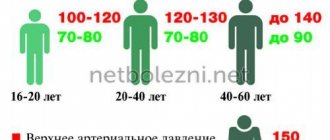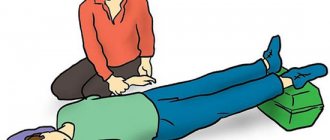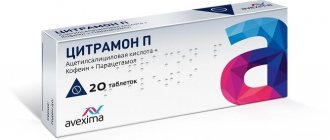Hypertension (essential or primary hypertension) is a chronic disease associated with a long-term and persistent increase in blood pressure (BP).
There are two forms of hypertension (hypertension): primary and secondary. Approximately 90-95% of patients with hypertension have the primary form. Unlike secondary hypertension, primary hypertension does not have a clearly defined known cause. Therefore, its diagnosis is made after ruling out known causes, which include what is called secondary hypertension. For example, blood pressure may increase symptomatically with kidney disease, and so on.
Blood pressure: Blood pressure resulting from the work of the heart, which pumps blood into the vascular system, and vascular resistance.
Blood pressure readings are usually given as two numbers: for example, 120 over 80 (written as 120/80 mmHg).
The top number is called systolic blood pressure (the higher pressure and the first number recorded) - this is the pressure that blood puts on the walls of the artery when the heart contracts to pump it to peripheral organs and tissues. The bottom number is diastolic blood pressure (the lower pressure and the second number recorded) - this is the residual pressure exerted on the arteries when the heart relaxes between beats.
Normal blood pressure is a relative value, which depends on age, physical activity, psychological state, and even on the use of various medications.
Hypertension occurs when the body's smaller blood vessels (arterioles) narrow, causing the blood to put undue pressure on the vessel walls and causing the heart to work harder to maintain the pressure. In this case, blood pressure reaches or exceeds 140/90 mm Hg.
Diastolic blood pressure is more common in people under 50 years of age. As we age, systolic hypertension becomes a more serious problem. At least a quarter of the adult population (and more than half of those over 60) have high blood pressure.
Causes and risk factors
Despite many years of active research, there is no unifying hypothesis to account for the pathogenesis (mechanism of occurrence) of hypertension. In chronic long-standing hypertension, blood volume and cardiac output are often normal, so hypertension is maintained by increased systemic vascular resistance rather than increased cardiac output. There is also evidence of increased vascular tone. In addition, disturbances in the nervous and endocrine regulation of blood pressure play a role in the development of the disease.
Many factors can affect blood pressure, including:
- Genetic, which play an important role in the occurrence of hypertension.
- How much water and salt is in your body.
- The condition of your kidneys, nervous system and blood vessels.
- Levels of various body hormones.
- Age. Blood pressure gets higher as you get older. This is because blood vessels become stiffer as a person ages.
You are at increased risk of hypertension if you:
- Are you obese?
- Frequently experience stress or anxiety;
- Drinking too much alcohol;
- Consume too much salt;
- Have a family history of the disease:
- Diabetic;
- Smoke;
- You lead a sedentary lifestyle;
- You are experiencing stress.
Modern drugs
The standard treatment for hypertension is a combination of several approaches of classical medicine. There is a certain protocol that prescribes the doctor’s actions. It begins with an examination of the patient, a survey, a referral for examination, analysis of the results and preparation of a course of therapy. Focusing on the standard and generally accepted protocols, the doctor will be able to create an effective treatment for hypertension. First, the patient needs to go to the hospital at his place of residence. The further course of therapy will consist of the following stages:
- inpatient therapy;
- ambulatory treatment;
- rest and recovery, preferably in a sanatorium or resort.
In an inpatient setting, the patient is examined, the doctor analyzes the patient’s condition daily, prescribes medications and various procedures. When the person gets better, he is discharged to continue the course of therapy on an outpatient basis.
How to properly treat hypertension after discharge:
- The patient must go to the local doctor at his place of registration.
- He will be offered to undergo a course of physical therapy, he will definitely need to change his lifestyle and take medications.
- If elevated blood pressure is detected during therapy, the specialist adjusts the treatment regimen. If there are no complaints, the patient will be advised to rest more and go to a sanatorium or resort. The doctor will also list clinical recommendations that you will have to follow throughout your life.
Drug treatment is the mainstay of therapy for most diseases. It is used to get rid of high blood pressure in the later stages of hypertension. In the early stages, lifestyle correction mainly helps.
In the treatment of hypertension, consistency and the correct selection of medications are important.
When choosing medications, the doctor focuses on the following factors:
- financial condition of the patient;
- the presence of chronic pathologies;
- the stage in which hypertension is located;
- risk factors;
- state of the cardiovascular system.
ACE inhibitors
According to many experts, ACE inhibitors are excellent in helping to cope with hypertension. Due to their effect on the body, high blood pressure gradually drops, and against this background, the risk of developing complications decreases. In people with chronic heart failure, long-term use of ACE inhibitors improves the general condition and prognosis for further development of the pathology.
ACE inhibitors help reduce blood pressure by blocking the production of angiotensin I, from which angiotensin II must be formed. The latter causes vasospasm, which leads to the development of hypertension. Without angiotensin II, the patient's blood pressure drops and the degree of myocardial hypertrophy decreases.
Treatment of hypertension with ACE inhibitors may no longer be effective over time. With long-term use of drugs from this group, the second pathway of angiotensin II synthesis gradually becomes more relevant, namely through chymase in the organs and tissues of the body. In addition, taking ACE inhibitors can cause a sore throat and cough. The following drugs are used to treat high blood pressure from this group:
- "Enal";
- "Kapoten" (used for crises);
- "Amprilan";
- "Accupro";
- "Zokardis";
- "Diroton";
- "Monopril."
Treatment of hypertension should begin with low doses of inhibitors. They are gradually increased to achieve stable remission. Getting rid of blood pressure will not be easy; the whole process will take at least 3-4 weeks. Then you will need to take medications for preventive purposes for an even longer period (at least a year). The use of ACE inhibitors is prohibited in the following cases:
- pregnancy;
- angioedema due to the use of similar drugs;
- narrowing of the lumen of the arteries supplying the kidneys;
- excess potassium in the body.
Sartans
Sartans in medicine are also called receptor blockers that perceive angiotensin II, abbreviated as ARBs. The effects of this group of drugs are similar to ACE inhibitors. However, sartana makes angiotensin receptors completely insensitive to it, so the second pathway for the synthesis of this enzyme will not appear over time. For this reason, treating blood pressure with ARBs produces more lasting results. There are virtually no side effects after taking the medicine, but in rare cases a cough appears. The following drugs from this group can help relieve blood pressure:
- "Lorista";
- "Aprovel";
- "Mikardis";
- "Atakand";
- "Walz"
- "Edarbi";
- "Teveten";
- "Carsoad."
Calcium antagonists
Calcium antagonists are called calcium channel blockers. In case of arterial hypertension, treatment with them allows you to get rid of high blood pressure by dilating blood vessels and reducing their overall resistance. The result is achieved by blocking the flow of calcium. This reduces the sensitivity of blood vessels to vasoconstrictor factors.
Long-term use of calcium antagonists helps not only with how to treat arterial hypertension, but also allows you to achieve the following results:
- Reducing the likelihood of blood clots.
- Reducing the chance of developing complications of high blood pressure.
- Slowing down the formation of atherosclerotic plaques on the walls of blood vessels.
- Reduction of left ventricular hypertrophy.
Three groups of calcium antagonists are used to treat arterial hypertension. Each of them has its own characteristics.
- Dihydropyridines. They do not particularly affect myocardial contraction and cardiac conduction. Dihydropyridines act selectively on the vessel wall. With high blood pressure, treatment with them allows you to quickly stabilize the patient’s condition. Drugs from the dihydropyridine group come in short-acting and long-acting forms. Among them are “Cordaflex”, “Nifekard” and “Lekarmen”. With prolonged use, dihydropyridines can cause swelling.
- Phenylalkylamines. The essence of their action is to reduce the conductivity of the heart, thereby reducing the intensity of heart contractions. Phenylalkylamines have no effect on distant (peripheral) vessels. For hypertension, treatment consists of taking Isoptin or Finoptin tablets.
- Benzodiazepines. They are similar in their effects to phenylalkylamines. However, benzodiazepines can slightly constrict blood vessels, therefore, with high blood pressure, treatment with them should be carried out under the strict supervision of a doctor. Diltiazem can be distinguished from this group.
Diuretics
The effect of diuretics (diuretic drugs) on the body has been studied well enough to use this group of drugs to treat hypertension. They rid the patient’s body of excess moisture, thereby reducing the severity of hypertension. When used over a long period of time, diuretics cause a deficiency of potassium in the body, which helps muscles contract. If the supply of minerals is not replenished on time, the patient may experience convulsions. For this purpose, treatment for hypertension includes taking drugs that contain calcium (Asparkam) or using potassium-sparing diuretics (Triamterene).
How to beat hypertension? The following representatives of the group of diuretics will help in this matter:
- "Hypothiazide";
- "Trigrim";
- "Furasemide";
- "Diakarb."
B-blockers
They act on beta-adrenergic receptors, thereby reducing the influence of the sympathoadrenal system (SAS) on the heart. Against this background, the intensity of heart contractions decreases and the synthesis of renin in the kidneys stops. Modern treatment of hypertension allows the use of beta-blockers in the following cases:
- if arterial hypertension is accompanied by tachycardia;
- after a heart attack;
- in the presence of angina (pain behind the chest);
- if heart failure develops.
Among this group of drugs, the most popular ones can be identified:
- "Concor";
- "Lokren";
- "Nebilet";
- "Coriol";
- "Egilok".
Beta blockers cannot help get rid of hypertension forever, but they can stabilize blood pressure while taking it. Their use is prohibited in case of asthma and 2-3 degree block of the atrioventricular center.
Imidazoline receptor agonists
Imidazoline receptor agonists act on the central nervous system. Especially on I2-imidazoline receptors, which are localized in the medulla oblongata. The influence of drugs from this group reduces the activity of the sympathetic division of the autonomic (autonomic) nervous system. As a result of this process, the pressure and contraction of the heart muscle are stabilized.
Imidazoline receptor agonists not only help treat hypertension, but also improve metabolic processes, especially carbohydrate and fat metabolism. In addition, it has a positive effect on the brain, kidneys and cardiovascular system.
Of the representatives of this group, the following drugs are most often used:
- "Moxarel";
- "Moxonitex";
- "Albarel";
- "Moxonidine" (for crises).
Arterial hypertension is just one of the diseases for which imidazoline receptor agonists are prescribed. They are often used in the complex treatment of obesity and diabetes. The use of medications from this group is prohibited in the following cases:
- renal and heart failure;
- bradycardia (with a pulse less than 50);
- weakness of the sinus node;
- coronary syndrome.
Sometimes even a doctor finds it difficult to understand how to treat high blood pressure if the severity of the disease does not decrease. In such situations, the use of additional medications is allowed:
- renin inhibitors (Aliskiren);
- alpha-blockers (Alfuzosin, Doxazosin, Prazosin).
If you correctly combine basic antihypertensive medications with additional ones, you can improve the metabolism in the body. This will help get rid of high blood pressure forever. However, renin inhibitors and alpha-adrenergic receptors should be used only in complex therapy, and not as the only medicine. Comprehensive treatment of any pathology, including the fight against hypertension, consists of a combination of medications. Basically, doctors prescribe the following combinations of drugs:
- ACE inhibitor together with sartana and a diuretic drug.
- An ACE inhibitor together with sartana and a calcium channel blocker.
- ACE inhibitor, diuretic and calcium channel blocker.
Treatment for low blood pressure (hypotension) involves taking the following medications:
- Adaptogens. They are used due to their ability to narrow and increase vascular tone. During therapy, the patient's blood pressure, pulse and performance increase. Low blood pressure is treated with adaptogens such as Pantocrine or Saparal. Instead of tablets, in mild cases you can drink red wine, for example, “Cahors” 1 tbsp. l. in a day.
- Alpha adrenergic agonists. They are used when there is a strong drop in pressure; they act on alpha-adrenergic receptors, as a result of which the pressure increases and the blood vessels narrow. The most commonly used are “Gutron”, “Midamin” and “Mezaton”.
Classification of hypertension
There is no single classification, but the one recommended by WHO is most often used. Hypertension, depending on the degree of increase in pressure, is divided into three stages:
Stage 1 hypertension. Soft or borderline stage. The pressure is 140/90 mm Hg. or higher.
Stage 2 hypertension. Moderate stage. The pressure is 160/100 mmHg. or higher.
Hypertension stage 3. Severe form of hypertension. Clinical systolic blood pressure is 180 mmHg. or higher, and diastolic is 110 mm Hg. or higher.
The disease is also divided into three stages, depending on the degree of development:
Stage 1: slight increase in blood pressure. There are no complaints, the functioning of the cardiovascular system is not impaired.
Stage 2: constant increase in blood pressure and associated enlargement of the left ventricle of the heart.
Stage 3: increased blood pressure affects the functioning of the heart, brain and kidneys.
Course of hypertension
The risk associated with increased blood pressure is continuous, with each 2-3 mmHg increase in systolic blood pressure. Art.
Hypertension increases the risk of mortality from coronary heart disease by 7% and the risk of mortality from stroke by 10%. The most common immediate cause of death associated with hypertension is heart disease, but death from kidney failure is also common.
Complications arise directly from increased blood pressure (cerebral hemorrhage, retinopathy, left ventricular hypertrophy, congestive heart failure, arterial aneurysm and vascular rupture), from atherosclerosis (increased coronary, cerebral and renal vascular resistance), as well as from decreased blood flow and ischemia ( myocardial infarction, cerebral thrombosis, infarction and renal nephrosclerosis).
If your blood pressure is not well controlled, you are at risk of:
- Bleeding from the aorta, the largest blood vessel,
- Chronic kidney disease,
- Heart attack or heart failure,
- Poor blood supply to the legs,
- Vision problems
- Stroke,
- Disturbance of cerebral blood supply.
Treatment of hypertension at the Innovative Vascular Center
Our clinics employ experienced cardiologists who can accurately determine the causes of high blood pressure and prescribe therapy appropriate to the causes and stage of the disease.
In case of hypertension, we always conduct a thorough diagnostic search, identifying all possible causes of secondary hypertension, especially those related to vascular damage (vasorenal hypertension, increased blood pressure due to narrowing of the carotid arteries, in the presence of adrenal tumors).
At the Innovative Vascular Center, it is possible to correct the causes of arterial hypertension using endovascular methods (stenting of the renal arteries, radiofrequency denervation of the renal arteries).
Advantages of treating hypertension at the N. I. Pirogov Clinic:
- the opportunity to undergo all necessary examinations in the clinic within one day;
- own laboratory: test results - quickly and with a guarantee of reliability;
- individual approach: prescribing therapy taking into account the characteristics of your body, age and lifestyle;
- the opportunity to consult with other specialists within the same clinic;
- diagnostic equipment from leading Western companies;
- attentive and responsible medical staff.
Sign up for a consultation - together let's take control of your blood pressure!
Remember, hypertension is not a death sentence! Make an appointment











